Posted by Elena del Valle on June 1, 2009
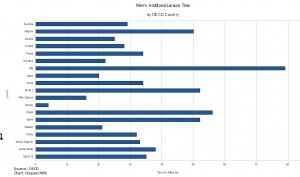
Click to enlarge
Do you think men and women share equally in the household duties? Do you think they both have the same amount of time free to enjoy activities of their choice? If you said yes you might be surprised by the results of a recent survey of Organization for Economic Co-operation and Development (OECD) conducted in 18 industrialized countries including the United States. According to researchers, men have more leisure time than women in all of the countries they examined.
The gap between the genders seems to be strongest in Catholic countries. For example, Italian men have 80 minutes more of leisure time than women in their country. Norway, on the other hand, seems to have the greatest gender equality when it comes to leisure time. In that country, men only have a few more minutes of leisure than women. American men have 40 minutes more leisure time per day than women.
What do people do when they have free time? In Mexico and Japan, they spend almost half their leisure time watching TV. People in New Zealand spend less than 25 percent of their leisure time watching the tube. People in Turkey, the most sociable nation, spend 35 percent of their leisure time entertaining friends. In Spain, people spend 13 percent of their time off doing physical activities, making that nation the most active one in that category.
The information was published in the latest edition of Society at a Glance, a publication of the OECD that features an overview of social trends and policy developments in OECD countries relying on indicators from OECD studies and other sources. One of the chapters in the report was dedicated to leisure time in the 18 OECD countries for which up-to-date time-use surveys are available from 2006, and based on nationally representative samples of between 4,000 and 200,000 people.
OECD provides a forum for member governments to compare policy experiences, “seek answers to common problems, identify good practice and coordinate domestic and international policies.”
“Happy for No Reason” audio recording

Presenter Marci Shimoff, author, Happy for No Reason
What: An audio presentation by Marci Shimoff and Q&A with Marci Shimoff and HispanicMPR.com audio program host Elena del Valle about finding happiness.
Available exclusively on HispanicMPR.com!
Click here to listen to a short interview with Marci
Click here for more information on “Happy for No Reason” audio recording with Marci Shimoff
Posted by Elena del Valle on May 27, 2009
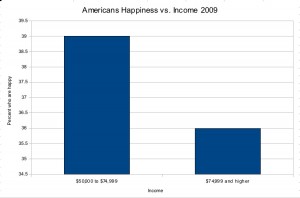
Americans Happiness vs Income 2009 - click to enlarge
How many Americans are happy today and what makes them happy? Good jobs? A high income? Family and friends? Researchers set out to find the answers to these questions by polling 2,401 adults in the United States online between April 13 and April 21, 2009. The results were a little surprising given the current state of the economy and the popular belief that money is the greatest source of happiness of all.
A little more than one third, 35 percent, of Americans said, last year and this year, that they are very happy in response to a Happiness Index online poll. Surprisingly, income did not equate to happiness among survey respondents. The group with the highest happiness index (39 percent) had an income between $50,000 and $74,999. The next group, with a 36 percent happiness index, earned $75,000 and higher.
In spite of the economic slump, African Americans and Hispanics who responded this year were happier than last year’s respondents. Last year, 35 percent of African Americans were happy as were 32 percent of Hispanics. This year, 41 percent of African Americans said they are happy and 36 percent of Latino respondents said they are happy. According to a Harris Interactive spokesperson no further information was gathered about emerging minorities in the polling process.
The poll also revealed that women who responded are slightly happier than men (36 percent versus 34 percent); and married women respondents are happier than single women (38 percent versus 34 percent). The survey also indicates that those with a high educational level tend to be happiest: while 33 percent of individuals with a high school or lower education said they are happy, 36 percent of respondents with some college and college graduates are happy, and 39 percent of those with a post graduate education are happy.
More Democrats were happy this year (from 33 percent to 36 percent) and fewer Republicans (39 percent to 37 percent). The researchers believe the changes may be related to the election of President Obama.
Harris Interactive conducts custom market research in North American, European and Asian offices and with the help of a network of independent market research firms.
“Happy for No Reason” audio recording

Presenter Marci Shimoff, author, Happy for No Reason
What: An audio presentation by Marci Shimoff and Q&A with Marci Shimoff and HispanicMPR.com audio program host Elena del Valle about finding happiness.
Available exclusively on HispanicMPR.com!
Click here to listen to a short interview with Marci
Click here for more information on “Happy for No Reason” audio recording with Marci Shimoff
Posted by Elena del Valle on May 22, 2009

Get Noticed Get Referrals
Jill Lublin has made a career of getting people to notice her. For 20 years she has found a way to make herself stand out. In her third book Get noticed Get Referrals: Build Your Client Base and Your Business by Making a Name for Yourself (McGraw-Hill, $16.95), she discusses her approach and shares tips on how publicists and brand managers might gain attention for their products and brands.
Her goal in writing the book, published last year, was to show readers how to develop relationships by using the same principles publicists and brand managers rely on to procure attention for their and their client’s brands. She shares insights on how to create a sound bite, an introductory and a message to promote connections or generate business. She also addresses myths and misconceptions, getting started, being flexible and keeping options open.
The 217-page paperback book is divided into 17 chapters: Starting Points; Getting It Straight; You Can’t Do It Alone; Myths and Misconceptions; Why Are you Knocking Yourself Out?; Where to Get Noticed; First Impressions; Goals, Intentions and Strategies; Cultivate the Media; Build on Your Passions; Focus, Focus, Focus; Always Keep It Real; Balancing It Out; Service Makes a Difference; Be Flexible and Keep Your Options Open; Fill It with Magic; and Summing Up.

Jill Lublin, author, Get Noticed Get Referrals
Lublin is chief executive officer of Promising Promotion and the author of Guerrilla Publicity and Networking Magic. She is the host of the nationally syndicated radio “Do the Dream” about celebrities who have achieved their dreams. She is also the creator and host of “The Connecting Minute,” a television show.

Get Noticed Get Referrals
Click here to buy Get Noticed… Get Referrals
Posted by Elena del Valle on May 20, 2009

Sometimes the United States Border Patrol utilizes horses in difficult terrain
Photo by James Tourtellotte (Border Patrol)
Immigration from Mexico to other countries, including the United States, declined sharply last year, according to an article in The New Times relying on Mexican government census data. The data released recently indicate a decline of 25 percent or 226,000 people immigrating from Mexico to other countries for the year that ended August 2008 compared to the previous year. Most of the immigrants headed to the United States.
Researchers believe that although heightened security at the border has played a role, the change is due mainly to a decrease in illegal crossings because of the economic hardships in the United States; and that the shrinking United States labor market results in fewer worker border crossings.
In addition, the final outflow of migrants from Mexico, taking into account departures and returns, dropped by half for the same time period ending in August 2008, according to data resulting from detailed household interviews conducted quarterly by the census agency in Mexico, the National Institute of Statistics and Geography.
In spite of the economic conditions in the United States the number of Mexicans living in the United States that returned to Mexico did not increase compared to the previous year, according to the Mexican census figures. Just under half a million Mexicans (450,000) returned to Mexico in 2008 as in 2007.
Although the Border Patrol force grew 17 percent to 17,500 agents last year it seems many who wish to reach the United States do in spite of the added security at the United States-Mexico border. However, crossing is expensive and arduous, requiring illegal travelers to rely on smugglers to make the crossing across scorching deserts and hidden mountain terrain. For example reaching Los Angeles from Mexicali, according to immigrants and social workers, costs $3,000 to $5,000 in smugglers’ fees. The high fees combined with lower income make the illegal crossing less appealing.
Eventually, it is likely past immigration patterns from Mexico to the United States will resume. The Center for Comparative Immigration Studies at the University of California, San Diego interviewed one thousand Mexicans in California and in a Yucatan village that has had many migrants in the past. Based on the interviews the researchers concluded that once the job market rebounds in the United States Mexican workers will return.
Discover from a new mom market expert how to reach Latino moms by listening to
“Marketing to New Hispanic Moms – a case study” audio recording

Presenter Cynthia Nelson, COO, Todobebe
Find out about
• New Latina mom market
• Baby demographics including market size, profile
• New moms’ language preferences
• Latino baby market trends
• Factors influencing Hispanic baby market
• Location of new Hispanic moms’ market
• Issues affecting new Latino moms
• Todobebe strategies
Click for information on “Marketing to New Hispanic Moms – a case study”
Posted by Elena del Valle on May 18, 2009
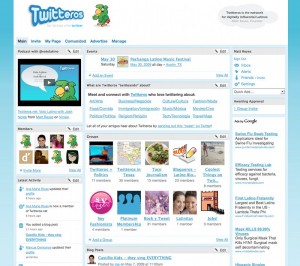
A Twitteros page
It took Matt Reyes a month to design and create Twitteros, a social networking site to extend the conversation from Twitter among Latino users, in December 2008 and now he has 200 subscribers. According to the website the portal reaches 691 users every month and 74 percent of them are in the United States. It skews toward educated, middle aged people with a slightly higher percent of men than women.
“So I recently stumble upon Twitteros I thought it was an interesting concept since its sort works like a lounge where all Latinos that Tweet get together, so I do go there once in a while to follow the new Latino members that join the Twitteros site,” said Steve Alfaro, digital director, Voto Latino Online.
Despite the familiar sounding name, the new portal is not affiliated in any way with Twitter, the well known micro blogging portal. Twitteros is divided into Main, My Page, Comunidad and Advertising sections. Discussion categories are Culture, Technology, Business, Music, Movies, Politics, Food, Fashion, Travel, Art, Immigration and Religion.
After reading Get Back in the Box by Douglas Rushkoff Reyes was inspired to build “something from the bottom-up where Latinos could have a voice and use it to be influential online.” A user of Twitter for the past year, Reyes believes the members of his new website are the ones that build the content and “do all the help.” Anyone who wants to contribute as a digitally influential Latino is welcome to join, he said by email.

Matt Reyes, creator of Twitteros
“I created this site with the knowledge that Latinos are social by nature, whether it be through activism, art, or just having a good time. There are currently no websites that have a sole focus on digitally influential Latinos,” said Reyes, creator of Twitteros. It is my belief that Twitter gives everyone a chance to have their voice heard. Members are not only active on Twitter but are also active with blogging. With these tools, we are truly giving the internet what it craves.”
The Austin, Texas resident explained that since Twitter doesn’t offer group and community support, Twitteros.net fills that void. He relies on word of mouth to promote his website. When he is not devoted to his Twitteros portal, Reyes does new media consulting, design, and development for brands and organizations for his company, the Department of Influence.

The Twitteros bird
Reyes describes himself as a digital influence strategist. He believes Twitteros offers brands and organizations the chance to create custom word-of-mouth programs to engage their customers in an open and transparent way. The portal offers advertising to cover operating expenses. Designer Chris Bomely created a Twitteros mascot which is described by Reyes as a Latino version of the Twitter Bird.
“Search Engine Marketing to Hispanics” audio recording

Presenter Matias Perel, founder and president, Latin3
Find out about
- The 16 million Latino online users
- Types of online access among Hispanics
- Latino online user language preferences
- What they do online
- Usage by age
- Income levels among Hispanics who visit the Internet
- Internet use by Hispanics
Click here for information on Search Engine Marketing to Hispanics
Posted by Elena del Valle on May 15, 2009
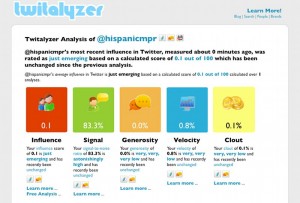
Twitalyzer results for HispanicMPR
Following up on the first About Twitter article, the question is whether the popular social networking site serves a business purpose. According to Steve Alfavo, digital director of Voto Latino Online, who has been a Twitter user since March 2009 it does:
HispanicMPR: What do you like, not like, etc. about Twitter?
SA: Twitter is not like other social networking sites, its a whole new experience. Twitter is like the Wii you can’t compare it to the other gaming systems like Playstation or Xbox because its just a whole different experience. What I Iike about Twitter is the power it has to spread information and connect with people, for example I run the Voto Latino Twitter account and I been trying to build our following, so I recently sent out a tweet to our network asking them to ReTweet it, well Craig Newmark the founder of Craigs List saw my tweet and re-tweeted our message to his own network and a couple minutes later from 950 I was finally up to 1000 followers.

Steve Alfaro, digital director, Voto Latino Online
I think its was really cool that he did that and that just shows the power of twitter, his following is huge 11,152 people so with one tweet he was able to help us out. Its a great tool to use if you learn how to use it. What I don’t like about Twitter is the way your twitter friends our displayed, its really hard to find people, sometimes its hard to write long messages because your only allowed 140 and even though that bugs me when I have long message I hope they keep it that way, the point of twitter is to send short messages. Marketing companies are starting to join twitter and spamming the twitter universe, it can get annoying.
HispanicMPR: In other words, why do you Twitter?
SA: I started because of work and because its easy to let others know about important information but I also also have a personal account that I use and with that I just use it to inform people about personal projects that I am working on, my personal twitter network is different from the Voto Latino network so my tweets are very different and since I run two accounts that probably makes me an twitter addict.
HispanicMPR: How often do you Twitter?
SA: I tweet for Voto Latino everyday, I try to tweet as many messages as possible, I feel in order for Twitter to work for you, you must be an active user which requires lots time but it definitely works.
A Twitter tool, Twitalyzer, identifies the most influential users according to their average influence, signal-to-noise ratio, generosity, velocity, and clout. Being influential relates to the number of people that follow a user, the number of times a user’s posts are referred to by others or “retweeted,” the number of times they refer to other people’s posts, and how often they publish updates each week.
Twitter defines its signal-to-noise ratio as people’s postings of information rather than anecdotes. A signal includes one or more of the following elements: references to other people (this is done with the @ preceding text), links to URL pages, hashtags visitors can explore (this is done with a # preceding text), and Retweets where a user passes to others information someone else shared (this is done with “retweet,” via, “rt” or “r/t/” in the post). The software adds these four elements and divides them by the number of updates to identify a signal to noise ratio.
Twitter defines velocity as a user’s rate of posts each week. For example, six updates in a week is considered very, very low by Twitter. The system is limited to searches of 1,500 records so users are judged against a theoretical maximum of 1,500 weekly updates. Clout is the likelihood that other people will reference someone in Twitter. The more that people reference someone the higher that user’s clout in the system. Clout is calculated by estimating a user’s number of references divided by the total number of possible references (as estimated by the Twitter Search APIs).
The top rated Twitter at the time of this writing was Zaibatsu (Reg Saddler) who is listed as a technology podcast co-host. However, the top 10 Twitter pages at the time of this writing linked to company pages or websites rather than the pages of individual bloggers. In other words, people or companies were driving traffic to their pages and content through Twitter posts. Zaibatsu had 80,269 followers and was following 81,541 people. That user had an influence ratio of 84.5 percent, a signal ratio of 88.2 percent, a generosity rating of 47.8 percent as well as clout and velocity of 100 percent.
The second listing was for BNO News, a news wire service with an influence of 83.4 percent, signal of 8.4 percent, no generosity, a clout of 100 percent and velocity of 77.5 percent; followed by 329,649 and followed 5. Others on the list were guykawasaki followed by 115,034 and following 116.782, nytimes with 785,257 followers and following 130, TechCrunch with 518,036 and following 687, Mashable with 573,852 followers and following 1,878, The Onion with 671,545 followers and following 321,245, Pogue with 265,315 followers and following 919, iamdiddy with 805,398 followers and following 122, and Twitter_Tips with 84,088 followers and following 78,931.
Guykawasaki’s Twitter page led to an Alltop, an “online magazine rack;” likewise the Twitter nytimes page led to the New York newspaper’s online portal; TechCrunch led to a blog about Internet products and companies by the same name; Mashable led to the social media blog’s homepage; The Onion led to an online news portal; Pogue led to Pogue’s Pages, a portal for David Pogue a technology columnist and writer; iamdiddy led to LastTraintoParis, a commercial entertainment page; and Twitter_Tips led to TweetSmarter.com, a portal with pages on how to produce better Tweets.
HispanicMPR has a Twitter account. According to the Twitalyzer our newly established account is just emerging and has an influence and clout of .1 percent, no generosity and a velocity of .8 percent; it was puzzling that the analysis revealed a signal of 83.3 percent. Since all the posts were informational shouldn’t the signal score, by Twitter’s own definition, have been 100 percent?
“Moving Beyond Traditional Media Measurement: measuring conversations and social media” audio recording

Presenter Katie Delahaye Paine, founder, KDPaine & Partners
Find out about
- Issues affecting online public relationships today
- Testing relationships as part of a survey
- Measuring ethnic group relationships
- Measuring foreign language communications in a similar ways to English
- Biggest challenges measuring conversations and social media
- Measuring online relationships with little or no money
Click here for information on “Moving Beyond Traditional Media Measurement”
Posted by Elena del Valle on May 13, 2009

Heidi Richards Mooney, a Twitter fan
Twitter, an increasingly popular social networking site created because a man by the name of Jack Dorsey wanted to know what his friends were doing, is known best for the limited size of its posts. Funded initially by Obvious in San Francisco, California Twitter enthusiasts built and launched the first prototype in two weeks in March 2006. By August of that same year it opened to the public. Following rapid growth Twitter was incorporated May 2007.
What makes it special and popular? It seems to be, at least in part, the short postings and simple format. Visitors to the Twitter website find one question on their screen, “What are you doing?” Replies are limited to 140 characters or less. In order to participate and reply visitors must be subscribers to the service. They can send messages via mobile texting, instant message, and the web.
“Twitter is the world’s largest networking party! Where else can you meet anyone from world leaders to leaders of small companies, and learn and share? The give and take is what Twitter is all about,” said Heidi Richards Mooney, author, entrepreneur, and business coach, by email.
Twitter has been in the news lately because of a recent Nielsen study that indicates the booming portal is losing 60 percent of new subscribers each month. In other words, people stop using the service shortly after signing up. In reaching their conclusions, Nielsen analysts, according to an online article, took into account 30 Web sites and applications that feed into the Twitter community including TweetDeck, TwitPic, Twitstat, Hootsuite, EasyTweets, and Tumblr.
According to the Twitter website, the company “has many appealing opportunities for generating revenue but we are holding off on implementation for now because we don’t want to distract ourselves from the more important work at hand which is to create a compelling service and great user experience for millions of people around the world. While our business model is in a research phase, we spend more money than we make.”
Without a source of income and no advertising revenue can Twitter survive long term? Does it play a useful role? Should it survive? The company did not reply to several emails (there was no phone number listed in the contact page). While those who like Twitter find it valuable some people are saturated with social networking and can’t find the time for another task in their day. Others don’t see the usefulness of the short messages and prefer to rely on classic communication methods and traditional social networking sites.
“Twitter is one communication system too many for me! Between the radio, the web, FB, and Linkedin – I’m maxed out!” said a west coast radio host.

Claudia Miani, another Twitter enthusiast
“I use twitter professionally, from a PR perspective, to stay in touch with news producers and tweet stories to them when they are on the hunt for story ideas. I also follow several PR/ Social Media gurus’ tweets that lead to dozens of articles on the latest developments of social media, PR best practice cases, etc.,” said Claudia Miani, account supervisor at Accentmarketing in Coral Gables, Florida. “As a result of this, I am able to share learnings with my colleagues at Accentmarketing, clients and the industry which leads to an increase in followers each day. The key to growing the number of your followers is to keep updating relevant information on what you are passionate about.”
“Moving Beyond Traditional Media Measurement: measuring conversations and social media” audio recording

Presenter Katie Delahaye Paine, founder, KDPaine & Partners
Find out about
- Issues affecting online public relationships today
- Testing relationships as part of a survey
- Measuring ethnic group relationships
- Measuring foreign language communications in a similar ways to English
- Biggest challenges measuring conversations and social media
- Measuring online relationships with little or no money
Click here for information on “Moving Beyond Traditional Media Measurement”
Posted by Elena del Valle on May 12, 2009

Jeremias, Valeria Gastaldi and Baby Bash
Smirnoff Ice and Univision are partnering for Fiestas Chulas, a summer concert series scheduled to take place in San Antonio, Miami and Los Angeles beginning this month and ending in September. Tickets are free and available through Coolcontodos.com, the concert series website (subscription required), and Univision Radio stations.
The first event will take place May 22 at the Pavilion at Sunset Station where Baby Bash and Valeria Gastaldi will be performing. The next event is scheduled to be held July 3 at the Gibson Showroom in Miami. Jeremias is expected to perform unplugged. Finally, Ozomatli and Valeria Gastaldi will perform September 11 in Los Angeles.
Posted by Elena del Valle on May 6, 2009
By Jon Glass, M. Ed.
Doctoral candidate
Psychology Department
Gannon University

Jon Glass, M. Ed.
Over the past thirty years, social scientists have expanded our understanding of the role that fathers play in child development. Prior to this time, researchers looked almost exclusively at mothers; it was as if fathers’ mere presence, or lack thereof, was enough. Not surprisingly, current data suggests that fathers play a critical role in the family. Positive paternal involvement leads to improved school performance, positive self-esteem, better sibling relationships, and improved mental health outcomes for children. Furthermore, when fathers remain responsible for, engaged with, and accessible to the family, marriages are stronger and pooled financial resources lead to a higher standard of living. Thus, fathers have both a direct and indirect influence on family relationships and stability.
Click here to read the complete article
“Latino Family Dynamics” audio recording


Brenda Hurley and Liria Barbosa
Discuss
- Latino purchasing habits and products they favor
- Latino family characteristics
- Latinos and extended families
- Division of duties, responsibilities within the family
- Who is the decision maker in the Latino family
- Who is the information provider in the Latino family
Click here to find out about Latino purchasing habits and “Latino Family Dynamics”
Posted by Elena del Valle on May 1, 2009
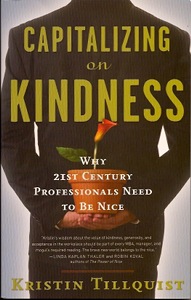
Capitalizing on Kindness
Kirstin Tillquist, a former attorney turned chief of staff to the mayor of the City of Riverside, California, has experience working with politicians and influential people. She firmly believes one of the most, if not the single most, important attitude in business today is kindness. She explains why in her newly published book, Capitalizing on Kindness Why 21st Century Professionals Need to Be Nice (Career Press, $15,99).
The 255-page softcover book is divided into seven chapters: Kindness Capital, The Power of Reputation, The Power of Reciprocity, The Power of Personality, The Power of Thanks, The Power of Connecting, and From Success to Significance. In it she explains that the type of kindness she refers to is a combination of a caring attitude with a smart and strong business approach. Self sacrificing give til you drop and quiet types will not necessarily reap the benefits she speaks of although they may feel rewarded for their actions in private.
She argues that many business people believe falsely that there is a choice between being kind and being successful. Instead, kind people become successful. She sets out to explain to her readers how to be kind in business and develop “kindness capital,” a concept she defines loosely as “what is built up when you consciously set out to be kinder and develop your skills at applying kindness.”
According to Tillquist, kindness results in higher productivity, lower absenteeism, and lower likelihood of being sued. The author emphasizes the benefits of the five Powers of Kindness: Reputation, Reciprocity, Personality, Thanks and Connecting. She is a business consultant, speaker, columnist, and trainer on business kindness.

Capitalizing on Kindness
Click here to buy Capitalizing on Kindness
































